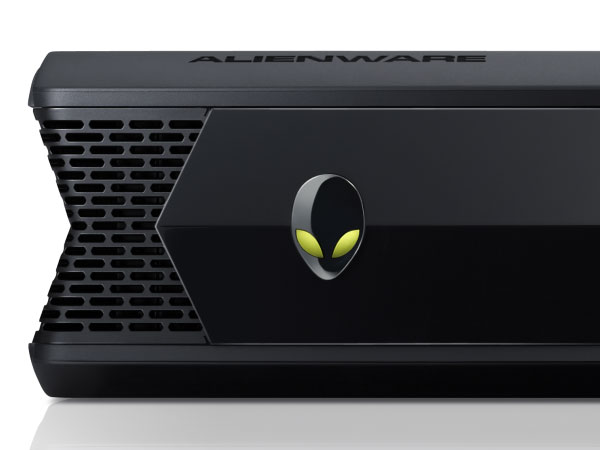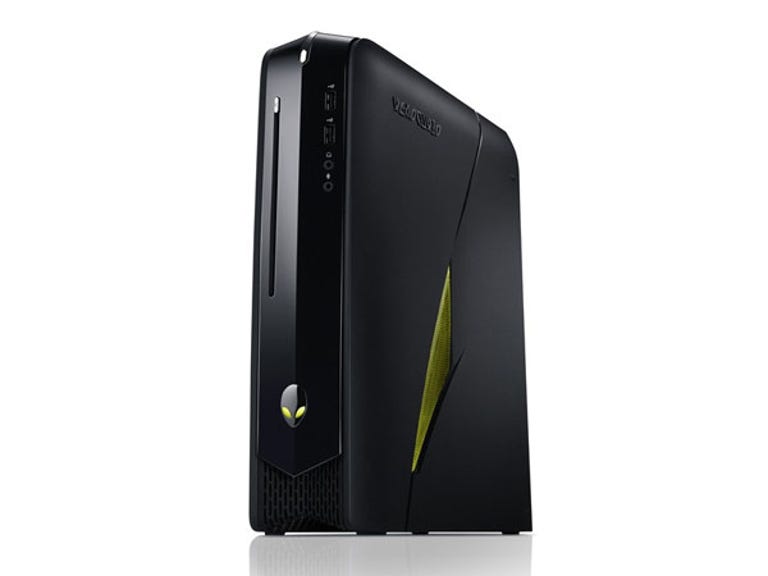 Why You Can Trust CNET
Why You Can Trust CNET Alienware X51 review: Alienware X51
The X51 is a beast in a tiny box. You sacrifice on your upgrade path by getting something this small, but if you're after something tiny that still manages to be a decent gaming machine, this could pique your interest.
In something that approximates console-size, Alienware has released an intriguing little machine that also manages to be a high-powered PC. If you want a powerful PC but can no longer justify the size, time and effort in building one yourself, it's a tempting option.
The Good
The Bad
The Bottom Line
The X51 will happily sit in portrait or landscape orientation, and just like the PS3 it allows you to rotate its front-mounted logo so it's always upright. Its aesthetic is typical Alienware, with bits that light up, and the user being able to change what colour those bits are.

The alien head rotates to match the orientation, and glows.
(Credit: Alienware)
The X51 owes its diminutive size to two factors: firstly, Alienware has split the power supply out of the box, providing one of the hugest power bricks we've seen (330W for the SKUs that carry the GTX 555, 240W for the GTX 545). The second conceit is something that has been employed in servers for a long time: using a riser board to change the orientation of the graphics card from vertical to horizontal. Pair this with a Mini-ITX board, and things start making a whole lot of sense.
The riser board flips the graphics card orientation 90 degrees.
(Credit: CBSi)
The standard parts mean that there's some wiggle room for upgrading your CPU, wireless card, RAM or optical drive; however, you're limited to the 330W power supply (if you order one of the higher-end SKUs), something that really can't take more than a 150W GPU. GPU length is also limited, and although you could possibly set up a solid-state drive (SSD) plus mechanical hard drive solution, you'd have to find some adhesive to attach the SSD as there's no dedicated mounting point for it. In saying that, there is a gap above the optical drive that a 9.5mm SSD could fit in if it were taped down.
The HTPC question
There's going to be a few folk immediately thinking "home theatre" with this one. It could certainly do that job, although you may have to customise it to minimise noise.
The CPU fan is by and large quiet enough to not distract from movie watching, but it does have the potential to hit howling level if it needs to. The fan and baffle are a custom job, taking advantage of the X51's tightly packed internals — so finding something low profile and quiet enough to replace them may be a challenge. It's certainly quieter than an original Xbox 360 when gaming, but some may still consider this too loud.
Also, the 1-terabyte Seagate drive included with our review sample (and indeed, all SKUs of the X51 in Australia) isn't the quietest of drives. At 3 metres away we could still hear it grinding away, and the lack of SSD option means you'll have to supply your own if you want total silence.
The included keyboard and mouse are wired, which is more inhibitors to home theatre PC (HTPC) use. Both are passable efforts usability-wise, but they feel a little cheap for an Alienware product. There's no media remote bundled at all.
It does come with a Blu-ray drive, though, and there's optical audio out. A full-sized HDMI port is on the back, which, through the magic of Nvidia's Optimus, will use the integrated Intel HD Graphics when doing light work, and Nvidia's GeForce GTX 545/555 when doing heavy lifting. There's also a mini-HDMI port on the GeForce itself if you want to guarantee Nvidia output all the time.
Power
So it's powerful right? Well, with a GTX 555 in there, along with a Core i7 2600 and 8GB of RAM, it does incredibly well for the size. Alienware's even managed to jam a wireless controller in there (although it's 2.4GHz only), and the whole thing will set you back AU$1699.
The PC also has you reasonably well covered for ports, too. Despite its size, the X51 manages to fit in eight USB ports (two of which are USB 3.0, but are vexingly located at the back of the machine), gigabit Ethernet, 5.1 sound, optical and coax audio, HDMI out, and headphone/microphone jacks on the front. The full-sized graphics card brings dual DVI and mini-HDMI, and that's it for ports. Not having eSATA might be a concern for some.
The tightly packed X51 will limit what upgrades you can perform, along with the limited power supply.
(Credit: CBSi)
There are two lower tiers to the X51 if you've got a tighter budget — an AU$1499 model drops the processor to a Core i5 2320 and GeForce GTX 545, while AU$1299 will pick you up the same processor and graphics card, but drop you to 4GB RAM and include a DVD drive instead of Blu-ray. Across the board there are no configuration options on Dell's website at the time of writing — the lack of SSD option is curious.
The external power adapter means Alienware has to be smart with how it uses its power supply, and the use of Optimus definitely helps here while also reducing your power bills and internal system heat, at least for single monitor systems; plugging up the Intel HDMI port and Nvidia DVI port to different monitors resulted in the GeForce running both interfaces permanently. If your monitor has a resolution higher than 1920x1080 you'll miss out on Optimus as well, as that's the maximum resolution HDMI will feed.
Being an Alienware machine, it of course ate our benchmarks for breakfast. We haven't covered gaming PCs for a while, and so all we have to compare to are all-in-ones, machines that use laptop parts. Just take a look at the difference that having even a small, yet fully fledged desktop can make.
Application performance
Choose a benchmark: Handbrake | iTunes | Photoshop | Multimedia
It's not exactly fair matching, pitting a Core i7 against Core i5 machines, along with a desktop graphics card versus mobile; but it does illustrate that you can still get a lot of power into a small box.
It also shows that the performance game is one of diminishing returns; unless you have a highly threaded application like Handbrake churning over, there's not that much of a gap between a high-end machine and a medium tier. It's significant, especially for power users and professionals, but for the average user they likely won't notice.
But we're here for gaming, right? Let's see what a mid-end desktop graphics card will do against mid-end mobile graphics cards.
Gaming performance
Choose a benchmark: Metro 2033 | Batman: Arkham Asylum
Game results are more dramatic, courtesy of the much beefier GTX 555 in the X51. The HP all-in-one features an AMD Radeon HD 6450, the Toshiba an Nvidia GT 540M. Both are reasonably well performing cards; but if you're a gamer it still makes a lot more sense to go for the full desktop over a mobile solution. Once again it's not the fairest comparison, but then, gaming desktops cross our path quite rarely.
Conclusion
The X51 is a beast in a tiny box. There are some concessions to be made from an upgrade perspective, but if you're after something tiny that manages to be a decent gaming machine, this could pique your interest.


